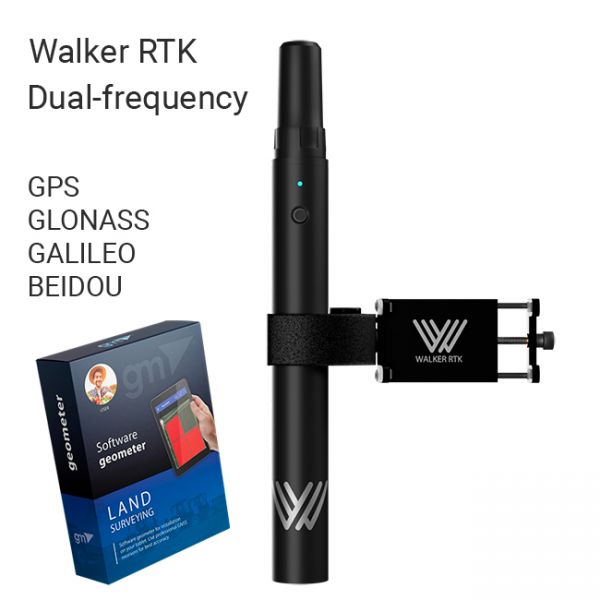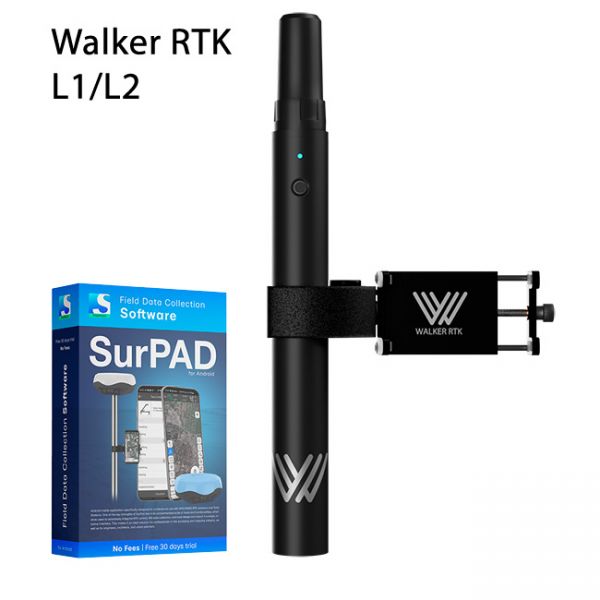Walker RTK: Why a compact GNSS receiver outperforms a smartphone with a built-in RTK module
20.06.2023Global Navigation Systems (GNSS) have become an integral part of the modern world, providing accurate positioning and navigation. One of the key developments in this field is the introduction of Real-Time Kinematic (RTK) technology, which allows obtaining high-precision results with millimeter accuracy. In this article, we'll look at why the compact Walker RTK GNSS receiver outperforms smartphones and tablets with a built-in RTK module.
Stability of obtaining a FIXED solution
It is an important question, because we are considering RTK receivers with absolute accuracy. The data received must be accurate and the accuracy must be reliable, even though some instruments have an internal RTK module, this does not always mean that the data is reliable.
The Walker RTK GNSS receiver, like a smartphone with an internal RTK module, can be used in the hand. Walker RTK compared to RTK-Smartphone will show better performance and stability of measurements. We will write about this in the block on constructive advantage.
This is essential in surveying and mapping applications where positioning accuracy and reliability are critical. With the help of a pole or a tripod, the Walker RTK can be placed at a higher level, providing a better viewing angle of the satellites and reducing the effect of interference on the signal.
Thus, the physical separation between the Walker RTK compact GNSS receiver and a smartphone with a built-in RTK module allows to improve the quality of the satellite signal and obtain more accurate positioning results in conditions with obstacles.
The positioning accuracy and design advantage of the Walker RTK
Another important advantage of the Walker RTK compact GNSS receiver is the possibility of accurate positioning with an accuracy of 1-2 cm. Smartphones are usually held in the user's hand, which makes it difficult to accurately determine their position, and the real accuracy in the hand can be at the level of 10-15 cm. At the same time, the Walker RTK can be mounted on a pole or tripod, allowing for geodetic accuracy.
The centimeter level of accuracy is particularly important in professional fields such as surveying, cartography, agriculture and construction, where measurement accuracy is of fundamental importance.
The reliability and stability of the RTK signal is another important factor in which the Walker RTK compact GNSS receiver has an advantage over smartphones and tablets with a built-in RTK module.
In smartphones, the satellite signal can be affected by various obstacles, including buildings, trees, terrain geometry and even the body of the human holding the smartphone. This may result in reduced signal quality and positioning accuracy.
In the case of the Walker RTK, its tubular design and antenna placement on top avoids obstructions that could interfere with a direct satellite signal. Additionally, using a pole or tripod allows you to place the receiver higher, providing a better view of the sky and a more reliable fixed signal.
Thanks to these physical features and the ability to install at higher positions, the Walker RTK provides a stable and reliable satellite signal even in obstructed conditions. This provides more accurate and reliable positioning results in professional applications where high signal quality and stability during measurements are important.
Limited specifications of RTK smartphones and RTK tablets
There is a significant drawback to smartphones with an internal RTK module - they have a limited ability to update the system and a limited period of support. This means that when you use a smartphone with a built-in RTK module, you will be limited to its original specifications and operating system, and will not be able to update to a newer version of Android.
This gives you more flexibility and the ability to update your system based on changing needs and technological advances. You can use a modern smartphone or tablet with an updated version of the Android OS, which provides more functions, security and support for new technologies.
In addition, the cost of upgrading the Walker RTK receiver will be significantly lower, since you do not need to replace the entire device, but only connect a new smartphone or tablet.
The Walker RTK with geometer mobile app is a compact and easy-to-use ideal tool for 3D surveying manholes, sidewalks, curbs, steps, landscaping, mapping trenches, and underground utilities such as electricity, gas, water, and sewer lines.
Walker RTK with professional surveying mobile application SurPAD is the ideal kit for surveying, as well as for 3D surveying manholes, sidewalks, curbs, steps, landscaping, mapping trenches, and underground utilities such as electricity, gas, water, and sewer lines




